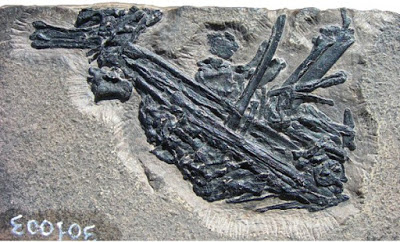
The University of Valencia leads a study that uses high-resolution imaging techniques to reinterpret fossilised bones first encountered in northeast Italy in 1989.
Fossils have long been a rich source of information on the animal species that inhabited the earth before us. Bones, teeth, prints and even excrement (known as fecal pellets) all form part of the fossil record studied by paleontologists. Exceptionally, the fossilised remains of animal bones regurgitated by other animals (gastric pellets) are also found, as is the case here: the study focuses on a rare gastric pellet found in 1989 near Preone (Udine, Italy) previously thought to contain the bones of a pterosaur reptile. However, 3D rendering techniques have recently revealed an affinity with a different reptile family, the protorosaurs.
Back in 1989 the remains were identified and reported as one of the very few cases of fossilised regurgitated pterosaur bones. Pterosaurs are a group of flying reptiles that lived during most of the Mesozoic Era (some 252 to 66 million years ago). The animal was likely hunted and eaten, albeit partially, by a large fish. Limited by technological capacity, its remains were ascribed to the only pterosaur known to have existed in this region, thePreondactylus buffarinii.
Researchers from the Institut Català de Paleontologia Miquel Crusafont (Miquel Crusafont Catalan Paleontology Institute, ICP) re-studied the remains using a technique called X-ray microtomography or X-ray microCT, which yields high-resolution 3D images. If an ordinary CT scan reveals information not visible from the outside, then here the detail was such that previously undetected anatomical features were identified, transforming the scientists’ interpretation of the contents of this gastric pellet: “The anatomical study of these images not only does not support the hypothesis that the bones belong to a pterosaur reptile, but also reveal a certain likeness with the protorosaur family. More specifically, with the Langobardisaurus pandolfii,” explains Borja Holgado, the main researcher behind this study. “The morphology of the extended vertebrae now identified as cervical and the articular facets (the surface where two bones meet) of the dorsal are the most striking features that led to this new interpretation,” he adds.
The protorosaurs are a group of reptiles with long necks similar to present-day lizards that lived between 260 and 210 million years ago, shortly before dinosaurs dominated all terrestrial ecosystems.
Researcher Fabio M. Dalla Vecchia, who also participated in this study, was one of the researchers who first analysed these remains in the nineties, attributing them to a pterosaur reptile. It was Dalla Vecchia himself who proposed the review. Hypothesising as to the origin of the pellet, he says: “This work confirms that it is a stomach regurgitation possibly produced by a large fish, as we identified in the first study.” The rocks where the fossil was found were confirmed to be of marine origin. However, there is no evidence of marine predator reptiles having inhabited either the immediate geological formation or in contemporary formations in the wider region. “This points to a fish as the best candidate for the regurgitation of these remains,” he concludes.
To clarify, the presence of a presumably terrestrial protorosaurian reptile in marine formations is not unusual. The fossil record in the study region includes abundant remains from land-based organisms, as well as organic matter of terrestrial origin. These flora and fauna would have lived in the vicinity of a water formation and been washed into it by natural phenomena such as tidal currents, storms or hurricanes.
Reference:
Borja Holgado, Fabio Marco Dalla Vecchia, Josep Fortuny, Federico Bernardini, Claudio Tuniz. A Reappraisal of the Purported Gastric Pellet with Pterosaurian Bones from the Upper Triassic of Italy. PLOS ONE, 2015; 10 (11): e0141275 DOI: 10.1371/journal.pone.0141275
Note: The above post is reprinted from materials provided by Asociación RUVID.










